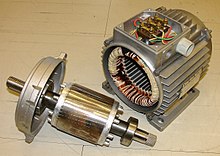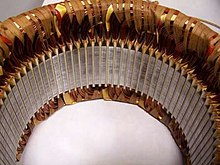
Back ثابت الآلة Arabic Stator Azerbaijani Статар Byelorussian Статар BE-X-OLD Статор Bulgarian Stator BS Estator Catalan Stator Czech Stator Danish Stator German
This article needs additional citations for verification. (May 2012) |



The stator is the stationary part of a rotary system,[1] found in electric generators, electric motors, sirens, mud motors, or biological rotors (such as bacterial flagella or ATP synthase). Energy flows through a stator to or from the rotating component of the system, the rotor. In an electric motor, the stator provides a magnetic field that drives the rotating armature; in a generator, the stator converts the rotating magnetic field to electric current. In fluid powered devices, the stator guides the flow of fluid to or from the rotating part of the system.
- ^ Klempner, Geoff; Kerszenbaum, Isidor (2004). Operation and Maintenance of Large Turbo-Generators. John Wiley & Sons. ISBN 978-0-471-61447-0.